They’re a measure of the goods-based economy.
Freight shipment volume across all modes of transportation – truck, rail, air, and barge – rose 8.2% in September, compared to a year earlier, according to the Cass Freight Index. While this is still a big jump, it’s down from the five double-digit increases earlier this year. The index covers merchandise for the consumer and industrial economy but does not include bulk commodities, such as grains or chemicals.
The chart below shows how the index changed from the same month a year earlier. Note the notorious cyclicality of the business, the peak increase in January of 12.5%, and the trend since then. Growth in shipments continues to be strong, indicating a strong goods-based economy, but that growth is leveling off somewhat:
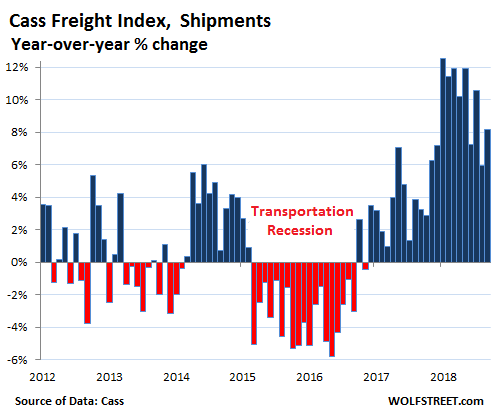
This blistering boom in early 2018 may have run its course, with growth in shipments still strong, but showing the first signs of leveling off. At the same time, trucking capacity-constraints, while still an issue, are abating.
The DAT Dry Van Barometer, cited in the Cass report, tracks demand for van trailers compared to available capacity. It highlights the cyclicality in the business, including the “transportation recession” in 2015 and 2016. The horizontal blue line (50) indicates equilibrium between demand for vans and capacity. Values above the line indicate demand exceeds capacity. Demand-capacity imbalances drive pricing power (click to enlarge):
Demand from the industrial sector shows up in demand for flatbed trailers that haul equipment and supplies for manufacturing, oil-and-gas drilling, construction, etc. As demand for flatbed trailers surged late last year capacity suddenly tightened in January in part due to the required use of Electronic Logging Devices (ELDs), and the DAT Flatbed Monthly Barometer, cited by Cass, spiked to historic highs. But the demand-capacity imbalances are now abating (click to enlarge):
In terms of rail, the Association of American Railroads reported that US railroads originated only 2.6% more carloads in September than a year earlier, but Intermodal traffic – containers and piggybacked trailers – rose 6.2%.
Only portions of the price increases are related to fuel costs. The average price of diesel at the pump, according to EIA data, at $3.39, is up 22% from a year ago, and truckers are clearly able to pass on these higher fuel prices:
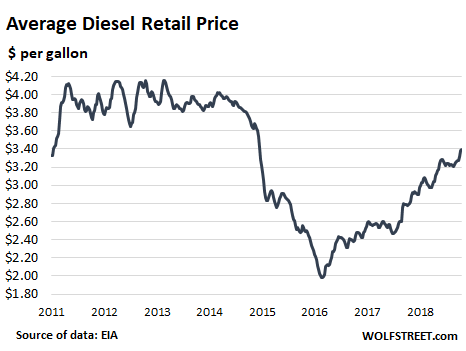
That factors other than fuel prices are involved in rate increases is highlighted by the Cass Truckload Linehaul Index, which tracks per-mile full-truckload pricing, and does not include fuel or fuel surcharges: it rose 9.8% in September, backing off the biggest year-over-year increase in the data going back to 2005:
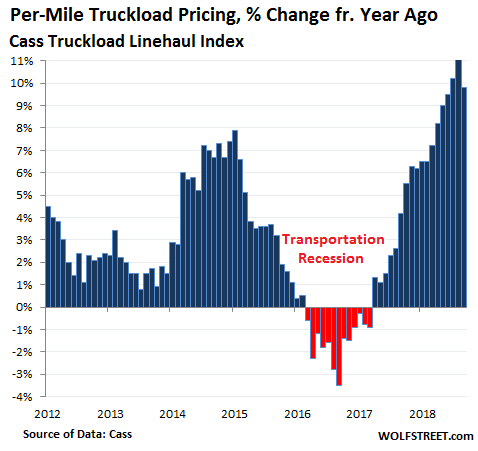
The Cass Intermodal Price Index, which includes fuel prices and fuel surcharges, rose 10.1% in September compared to a year ago, the 24th month in a row of year-over-year increases. The backtracking from the prior months was not much of a consolation for shippers, whose margins get squeezed by these prices unless they can pass it on to the next guy:
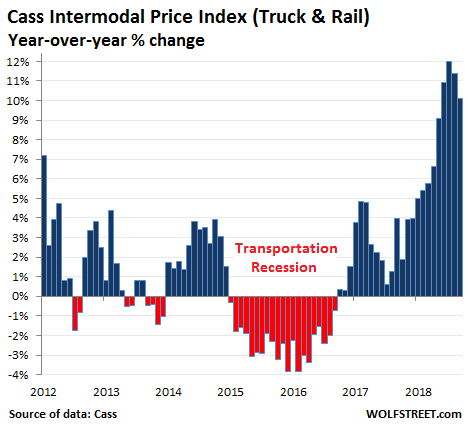
The total amount companies spent on shipping their merchandise via all modes of transportation – this is a result of higher shipment volumes at higher prices – surged 19.3% year-over-year in September, the biggest such increase since January 2012, and the 12th double-digit jump in a row, according to the Cass Freight Expenditures index.
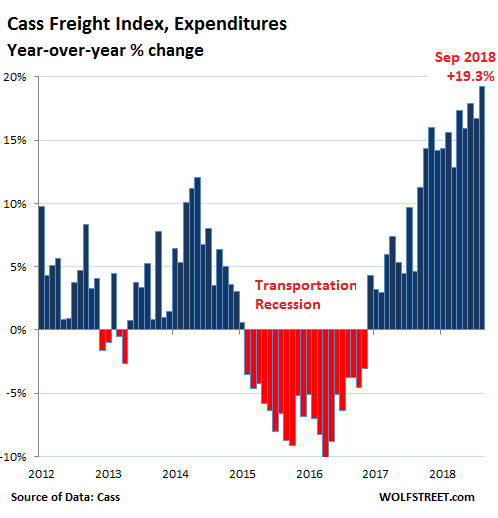
In September, it became clearer that the exponential increases earlier this year could not last. But demand remains strong, and capacity remains tight, just slightly less so than before.
Over the summer, and earlier this year, trucking companies have ordered record numbers of class-8 trucks. In September, the order numbers, while still strong, fell sharply off these records. This is why the trucking business is so cyclical – and you can see it coming. Read… Signs that the Trucking Boom Has Peaked
Enjoy reading WOLF STREET and want to support it? You can donate. I appreciate it immensely. Click on the mug to find out how:
![]()

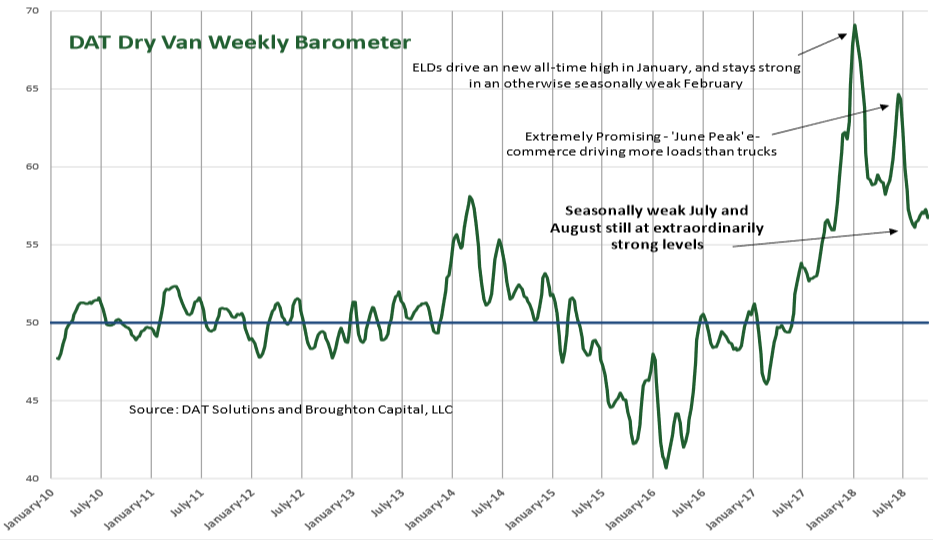
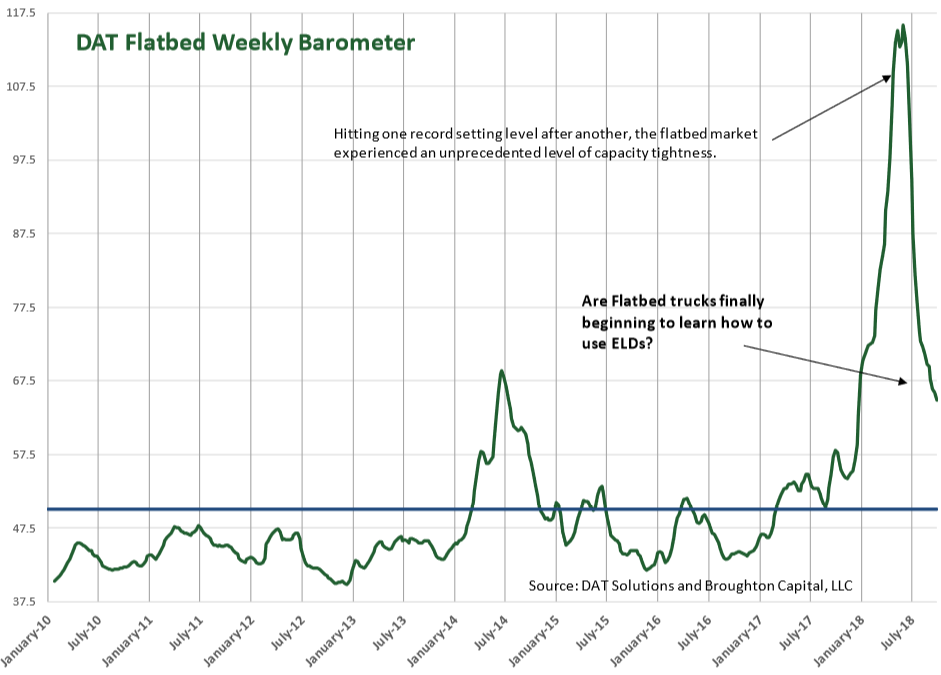

WR: any thoughts on what caused the transportation recession? There wasn’t an overall recession, was there?
The US goods-based economy went into a recession. But since the service sector is so much bigger, and kept growing, overall GDP still grew, but at a miserably low 1.6% in 2016.
A big factor in the recession of the goods-based economy was the pile-up of inventories. At some point, businesses tried to whittle them down by reducing their orders. And this ricocheted through the supply chains.
Aren’t inventories piling up again? A big part of the recent GDP strength has been inventory builds. How does the current inventory build compare to the prior one?
1. Yes, exactly.
2. Inventories are bigger now, but wholesales are also bigger, so the inventory-to-sales ratio has declined a little. Wholesales are big because everyone is stocking up and putting stuff in inventories. If final sales are slightly less than hoped for, suddenly the pile of inventories becomes a burden…. And it starts all over again.
This may help explain what went wrong in the markets in early 2016, we probably had a stealth recession signaled by the 2014 rise, this current spike being the harbinger of a bigger recession? May also be the economy is trying to reinflate and shake off effects from ZIRP. Sense here it is all tied to the energy markets.
Wolf,
I think it goes deeper than inventory adjustment. Obama was juicing the economy in his last few years to ensure a Hillary win. Evidence of federal spending and pork projects abounded. My guess (can’t prove) is that as Trump gained strength, alot of private business took a pause. Yes the inventory’s had built up in anticipation of more of the same spending but why did the pause come? Trump’s election revealed that while he is nuts, he’s not nuts enough to starve the economy. So the next big boom was launched.
Just a theory.
Obama couldn’t “juice” the economy even if he had wanted to because Congress has the power of the purse, and both the Senate and the House were run by Republicans, who swore that they’d oppose anything Obama wanted to do, and they certainly didn’t do anything that would have helped Clinton.
This is a comically delirious “theory”.
My guess is it largely played into the whole oil bust which was an apolitical event. Trump is not juicing the economy beyond whatever lower taxes and higher govt deficits are doing. Why do you think he’s so mad at Powell right now? Trump, king of debt, regardless of whatever he doesn’t understand appears to understand at the very least how higher interest rates can effect the economy. I would bet you he knows that higher interest rates mean higher debt servicing costs and for businesses on the edge that means more bankruptcy down the road. He’s afraid of losing our current economic growth trends. If the Fed reversed would it prevent an economic contraction? I have no idea but I do believe we’d be stuck in a very low growth environment if we did. The thing with Trump is, he can’t keep his mouth shut. More likely than not I believe he will eat his words, and politically he will take the blame when this debt based economic house of cards falls in on itself. I don’t inherently have a problem with that, but people will generally scapegoat and not recognize the Fed’s role in extending and exaggerating the business/credit cycle along with all the other lunacy that has been going on in markets and in board rooms.
“I think it goes deeper than inventory adjustment.”
Sounds full-on “deep state”. LOL!
“My guess (can’t prove) ”
Hmmm…I wonder why you can’t prove it.
Not meaning to ‘up set’ anyone but it seems a bit of a coincidence that the up tick occurred after President Trump came into office, and remains higher than previous years shown in the charts.
Are you then going to blame Trump when the down-tick arrives? That’s what you would have to do, and the down-tick will certainly arrive. Better not to get Presidents involved in trucking :-]
Wolf, maybe the announcement of tariffs caused an increase in inventory build to offset the coming disruption? The container shipping shows an increase and may support this. Another good article.
Exactly as they never was any growth in GDP and as everyone knows the stated GDP is always a total lie. Everyone is stockpiling to beat the onset of the tariffs from China. I’m simply amazed more people couldn’t see the real cause.
This is funny. Tick tock.
I’ve wondered for awhile if the electronic logging devices have added to the rise in equipment needs as drivers are now forced to pull over and sleep/rest running a shift at lower speeds.
This is apparent where I live when you see a domestic/local rig pulled over at a rest area and you know darn well they only have another 2-3 hours to a loading destination and a chance for shutdown.
Sometimes those guys pull off to time their deliveries. Before electronic logging you could move the numbers around, as long as it all fit. It probably has a lot to do with increased costs.
Normally a measure of the goods based economy but pretty sure they’re a measure of natural disasters and the need to replace goods the past few years.
I’m guessing this chart is going to drop off big time come January. I import high volumes of commodity raw materials from China and everybody is scrambling to import product into the U.S. in order to stock up before the next round of 15% tariffs hits at years end, which most importers are expecting to happen that this point (even though everyone in the industry thinks this is all madness). November and December transport numbers will be boosted because of this and then will steeply decline early next year. This next round of tariffs is different than the 10% passed on Sept 24th, because a cutoff date was actually provided on this next round whereas all importers were left guessing on the last – so were hesitant to rush ship. There is definitely a major urgency to beat this next round.
I think Sadie, Mick & rawtrader have provided some of the reasons for the increase in overall shipments, namely tariffs, natural disasters are contributing to the increases in freight volumes.
Excellent article by Wolf.
As a former Logistics Director, these type of reports are always illuminative as to manufacturers, distributors and retailers.
How do you think backing out of Postal treaty might affect this?
Matt P,
It seems this is many months away — if it happens, and if it won’t be replaced with a similar thing (see NAFTA – USMCA … “yous-ma-caw?”). So I don’t think this has impacted anything yet, and won’t impact anything for a while.
However, if it does happen, it might make direct shipments from China and India more expensive and somewhat less competitive with US competing products, and that would be a good thing. Transportation should never be subsidized. Amazon is into these direct shipments…
the transport boom is over.
buckle down and own my railroads for the duration.
Are flat beds benefiting from bottlenecks in the Permian, like the rails are?
This sounds like this might turn into something similar to the period 2015-2016 where S&P500 went nowhere as oil prices crashed (probably a good thing at that time) precipitated mostly by a global economic slowdown that lead to a US industrial /freight recession. With the TCJA stimulus effects good for another quarter downside might be limited..untill…. I am sure you know when.. Your thoughts?
I guess Obama got something right